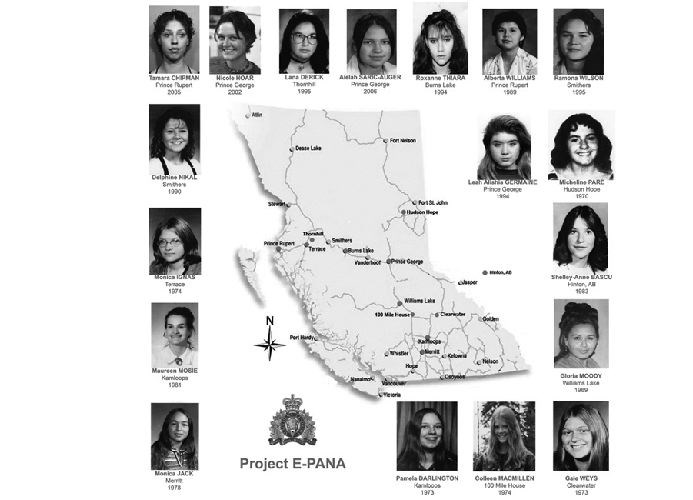The RCMP have officially linked 18 murdered or missing women to the Highway of Tears in their E-Pana investigation.
Unofficially, the number of women who have disappeared while hitchhiking or travelling along three highway corridors of north-central B.C. could far exceed that figure.
First Nations bands and community groups such as the Native Women's Association of Canada who spoke at the B.C. Missing Women Commission of Inquiry in 2010 claim as many as 43 women have been killed or gone missing along Highway 16.
E-Pana, an RCMP unit that formed in 2005, has centred its investigations on 18 teenaged girls and young women who have either disappeared or been found murdered from 1969 to 2006. While trying to determine if a serial killer was involved, members of the E-Pana task force have examined hundreds of unsolved murders, missing women files, and sexual assaults in the province over the past four decades which are believed to have happened within a mile of three B.C. highways. Police found enough similarities in each of the 18 cases to link them to the Highway of Tears. The name E-Pana is derived from RCMP code letter E for British Columbia and Pana, the Inuit name of the spirit goddess that tends souls just before they go to heaven and are reincarnated.
The Highway of Tears dates back to 1998 when the name was used at a vigil in Terrace to pay tribute to five women who at that time had disappeared along the 720-kilometre stretch of Highway 16 connecting Prince George to Prince Rupert. The scope of the investigation also extends to missing women cases close to Highway 97, which runs north and south of Prince George, and Highway 5, which connects Merritt to Valemount.
The 18 identified victims, with the year they went missing, where they were last seen or where their bodies were found, are: Gloria Moody, Williams Lake, murdered, 1969; Micheline Pare, Hudson's Hope, murdered, 1970; Gale Weys, Clearwater, murdered, 1973; Pamela Darlington, Kamloops, murdered, 1973; Monica Ignas, Terrace, murdered, 1974; Colleen MacMillen, 100 Mile House, murdered, 1974; Monica Jack, Merritt, murdered, 1978; Maureen Mosie, Kamloops, murdered, 1981; Shelly-ann Bascu, Hinton, Alta., missing since 1983; Alberta Williams, Prince Rupert, murdered, 1989; Romona Wilson, Smithers, murdered, 1994; Roxanne Thiara, Burns Lake, murdered, 1994; Alishia Germaine, Prince George, murdered, 1994; Lana Derrick, Terrace, missing since 1995; Nicole Hoar, Prince George, missing since 2002; Tamara Chipman, Prince Rupert, missing since 2005; Aielah Saric Auger, murdered, Prince George, 2006.
Of those 18, only MacMillen's murder has been solved. Police revealed on Tuesday an Interpol investigation in May found DNA evidence that linked convicted kidnapper Bobby Jack Fowler of Oregon to MacMillen's death. Police consider Fowler, who worked in Prince George as a roofer in 1974, a suspect in the deaths of two other B.C. women. Fowler died in an Oregon prison in 2006.
MacMillen disappeared on Aug. 9, 1974 near Lac La Hache, 291 kilometers south of Prince George, while hitchhiking to her girlfriend's house. Her body was found near a logging road about 25 kilometres south of 100 Mile House.
Moody, 27, the first Highway of Tears victim, was last seen leaving a bar in Williams Lake on Oct. 25, 1969. Her body was found the next day.
Hoar, a 25-year-old treeplanter, was last seen on June 21, 2002 hitchhiking to Smithers near the western city limit of Prince George on Highway 16 near Gauthier Road. Other Highway of Tears victims with direct connections to Prince George include Germaine, 15, whose stabbed body was found behind the former Haldi Road elementary school on Dec. 9, 1994, three hours after she was reported missing; Thiara, 15, a Prince George prostitute whose body was found near Burns Lake in 1994; and Saric-Auger, 14, whose body was found near Tabor Mountain, 17 kilometres east of the city, on Feb. 10, 2006.
Project E-Pana originally tied nine missing women's cases to the Highway of Tears in 2006, and nine more cases were added to the investigation in 2007. All the victims were female between the ages of 12 and 33 who were known at the time of their disappearance to have engaged in high-risk activities such as hitchhiking or drug use. Nine of the 18 were aboriginal, while the other nine were of Caucasian race.
Although she is not on the official Highway of Tears list, Deena Lyn Braem, 17, disappeared under similar circumstances in the early morning hours of Sept. 25, 1999 on a road just west of Quesnel. Police believe she might have been hitchhiking to return to her home in nearby Bouchie Lake. Her body was discovered by a hunter in December 1999 near Pinnacles Provincial Park.



